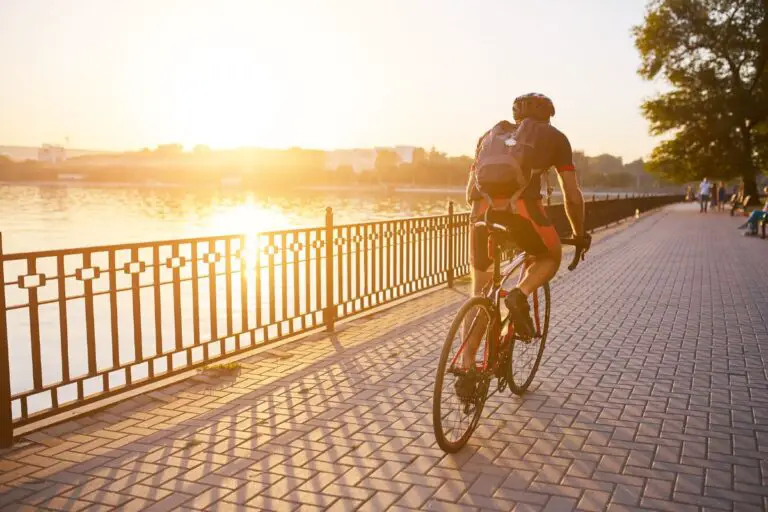So, you’re about to get started with road cycling. Good for you! To encourage you onward or to help those who don’t know where to begin, here is a comprehensive guide to get you rolling!
In this guide, I’ve drawn from my personal experiences and fellow cyclists’ wisdom to offer you a complete introduction. With information presented in an easy-to-digest format, this guide is the perfect companion for novice cyclists.
I’ll cover everything from picking out your first road bike to prepping for a ride and much more.
So, shall we begin our ride? Let’s hit the road!
Choosing and Buying Your First Road Bike
The prospect of buying your first road bike may seem daunting. You’re stepping into a world filled with terms like “drivetrain,” “wheelset,” and “saddle.”
No worries. I’ll make sure you’re well-equipped with everything you need.
Types of Road Bikes
First off, let’s get familiar with the different types of road bikes. Each one is tailored to a specific purpose, so understanding the differences is crucial:
- Racing Bikes: A need for speed? These are the bikes for you. They feature lightweight frames and aerodynamic designs for maximum speed and efficiency.
- Endurance Bikes: Built for comfort over long distances, these bikes are perfect if you plan to clock in some serious miles.
- Touring Bikes: These are the pack mules of road bikes. They’re designed for carrying gear over long distances, making them ideal for multi-day trips.
- Gravel Bikes: A hybrid of road and mountain bikes, gravel bikes are versatile and great for riding on various surfaces.
- Cyclocross Bikes: These are designed for mixed surface races, like grassy hills, and often have knobby tires for better off-road traction.
Now that you’re familiar with the types of bikes, it’s time to choose one that fits you and aligns with your preferences and budget. But how do you start?
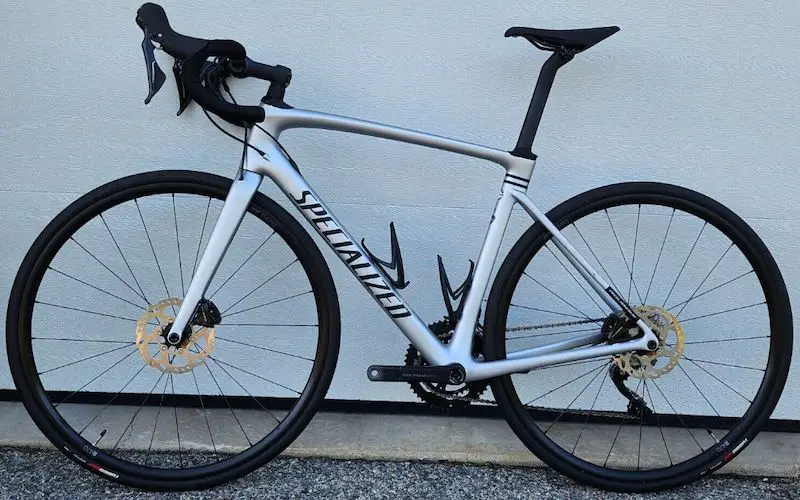
Achieving the Ideal Bike Fit
Next, you must find a bike that fits you perfectly. Kickstart this process by measuring your height and inseam length. For this, you’ll need a measuring tape or a plumb bob.
Once you have measurements, use a bike sizing guide or head to a local bike shop to determine the correct frame size. Websites like CompetitiveCyclist.com offer calculators that can help with this.
Then comes tweaking the saddle height and handlebar position for maximum comfort. You can use a level or ask a friend to help you. Minor adjustments can make a difference to your riding comfort.
Taking the time to find a bike that fits your needs and body will ensure that your initiation into road cycling is a smooth ride.
Key Components for Your First Road Bike
Now, let’s shift gears to the critical components. Here’s a breakdown of what to keep an eye on:
- Sturdy and Lightweight Frame: The heart of any bike is its frame. You’ll want something robust yet light. Typically, aluminum frames are an excellent choice for beginners due to their mix of price, durability, and weight.
- Reliable and Smooth Drivetrain: Consider this your bike’s engine. It converts your pedaling power into forward movement. Opt for a bike with a top-notch drivetrain to ensure an uninterrupted and efficient ride.
- Comfortable and Adjustable Saddle: Comfort is critical, especially on those long rides. An adjustable saddle will allow you to find the optimal position for maximum comfort and efficiency.
- Responsive and Powerful Braking System: Safety first, right? A reliable braking system ensures your bike stops when it needs to.
- Versatile and Stable Wheelset: This can significantly affect your ride’s comfort and speed. Consider the type of cycling you’ll do to choose the suitable wheelset.
Road Bike Models for Beginners
Now that you know what to look for, here are a few starter models that are perfect for beginners:
- Specialized Allez Sport: Known for its versatility, this bike is a reliable companion for your road cycling journey.
- Giant Contend 3: A fantastic option for those on a budget without compromising quality.
- Trek Domane AL 2: This bike offers a comfortable ride, making it ideal for those long cycling trips.
- Cannondale Synapse AL Sora: Perfect for comfort and performance.
- Fuji Sportif 1.9 Disc: A great all-rounder, this bike offers a comfortable ride with its endurance-oriented geometry.
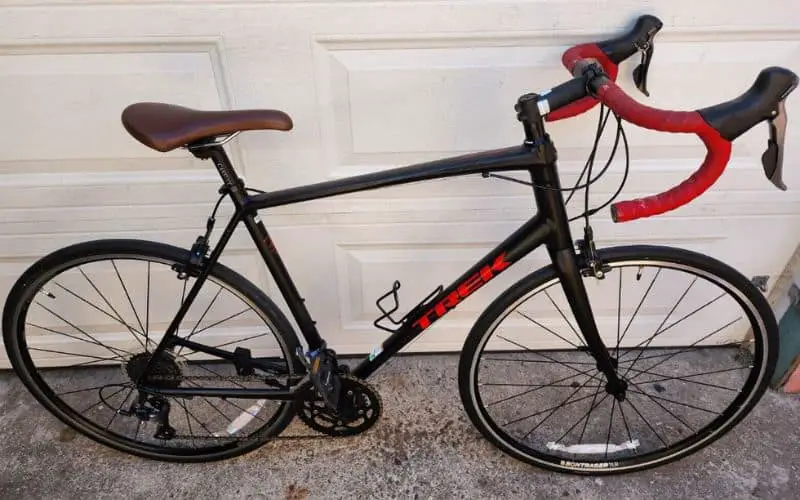
Scoring the Best Deals on Road Bikes
Here are some tips to help you find the best deals:
- Shop Around: Don’t limit yourself to one store or website. Prices can vary significantly.
- Negotiate: Don’t be afraid to haggle with sellers. You might be surprised at the discounts available.
- Look for Sales or Promotions: These events can offer substantial savings, particularly when a new model is about to hit the market.
- Consider Second-Hand or Refurbished Bikes: They can be an excellent choice if you’re on a tight budget.
Avoiding Pitfalls and Scams
Unfortunately, not all deals are as good as they appear. Here are some tips to help you avoid common scams:
- Check the Condition and Quality: Always inspect the bike thoroughly before buying – this is more for second-hand / refurbished bikes.
- Verify the Authenticity and Warranty: Ensure the bike is genuine and comes with a valid warranty.
- Avoid Overpaying or Underpaying: Research the market price for the bike you’re considering.
- Avoid Stolen or Damaged Bikes: Ask for proof of ownership and check if the bike has been reported stolen on websites like BikeIndex.org.
There you have it! You’re now armed with all this knowledge and ready to buy your first road bike!
The Basics of Riding a Road Bike
Learning the basic controls and techniques for riding a road bike is not as complex as it sounds. You’ll find yourself riding faster, smoother, and safer in no time.
You only need a little guidance; I’m here to provide just that!
Let’s get those wheels spinning, shall we?
Cycling 101: Learning the Controls
Much like a car’s steering wheel and pedals, road bike controls are your direct line of communication with your bike.
You need to know how to shift gears and use brakes effectively. And just like driving, the more you practice, the more it becomes second nature!
Shift into Gear
The left and right shifters on your handlebars control the front and rear gears, respectively. Shifting up increases resistance, making you go faster. On the flip side, shifting down decreases resistance, making pedaling easier.
You will shift up or down according to the terrain and your speed.
But here’s a pro tip: avoid cross-chaining or skipping gears. It can lead to wear and tear on your bike. Practice shifting one gear at a time.
If you need more help, check out this guide on how to change gears.
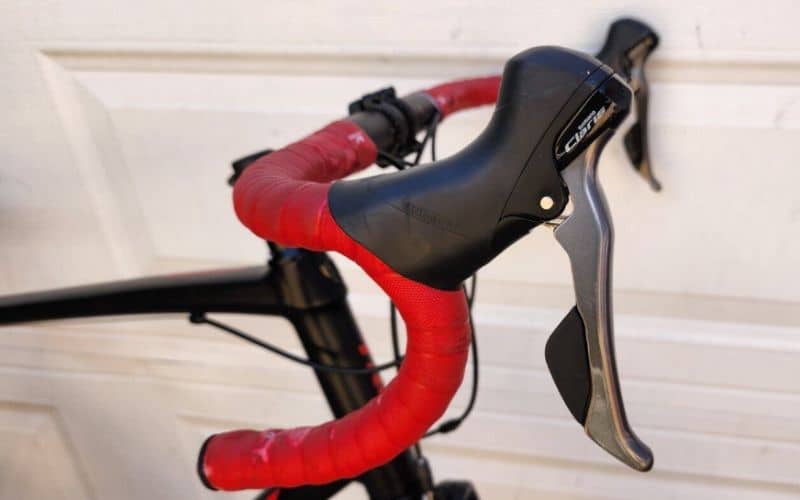
Braking: Stop Safely
Let’s talk about brakes.
The brake levers on your handlebars apply the front and rear brakes, helping you control speed and stop safely.
Gentle, gradual pressure is key here. Slamming on the brakes may lock up or skid the wheels; we definitely don’t want that.
Practice modulating your brake pressure, and you’ll get the hang of it quickly.
Road bikes have different brakes – rim brakes, disc brakes, and hydraulic brakes, each with pros and cons. Depending on your riding style and conditions, you might prefer one over the others. But that’s a topic for another day!
Essential Riding Techniques
Now, let’s talk about some essential riding techniques that will have you riding like a pro in no time.
Pacing 101: Finding Your Rhythm on a Road Bike
Just like a marathon, cycling isn’t won in a sprint. Pacing is key. You need to find your optimal cadence – the speed of your pedal strokes – and heart rate.
Let’s break it down:
- Optimal Cadence: Aim for a cadence between 80-100 revolutions per minute (RPM). Keeping a consistent cadence helps conserve energy and avoid fatigue.
- Heart Rate: Monitor your heart rate to avoid overexerting. Cycling computers or wearables like a Fitbit or Apple Watch can help.
- Gear Usage: Learn to use your gears effectively. Shift to easier gears while climbing and harder gears on flatter terrain to maintain a steady cadence.
Where to Look When Riding – Eyes on the Road
Road cycling requires your full attention. You need to watch for hazards, upcoming traffic, and road signs. Here’s where to focus your gaze:
- Look Ahead: Always scan the road ahead for potential hazards.
- Check Behind: Don’t forget to regularly check behind for other riders or vehicles.
- Monitor Your Speed: Monitor your speedometer or cycling computer to maintain a steady pace.
Handling Descents: Downhill Riding Techniques
Flying down a hill on a road bike can seem daunting, but it can be a thrilling part of your cycling experience with the right approach.
- Body Position: Lean back to shift your weight towards the bike’s rear to maintain balance.
- Effective Braking: Learn to use your brakes effectively. Feather both brakes lightly to slow down, rather than a hard squeeze, which could lead to skidding (and you flying over the handlebars!)
- Line Choice: Choose the best line for your descent. Look for the smoothest, straightest line down the hill to ensure a safe ride.
Turning with Confidence: Road Bike Cornering Techniques
Navigating turns on your road bike is an art. Here are some pointers:
- Slow Down: Always slow down before you approach the turn.
- Lean In: Lean into the turn rather than your bike. This helps keep your balance.
- Steer: Steer with your hips and shoulders, not just your hands.
- Accelerate: Once you’ve navigated the turn, it’s time to accelerate smoothly out of it. This will help you regain momentum.
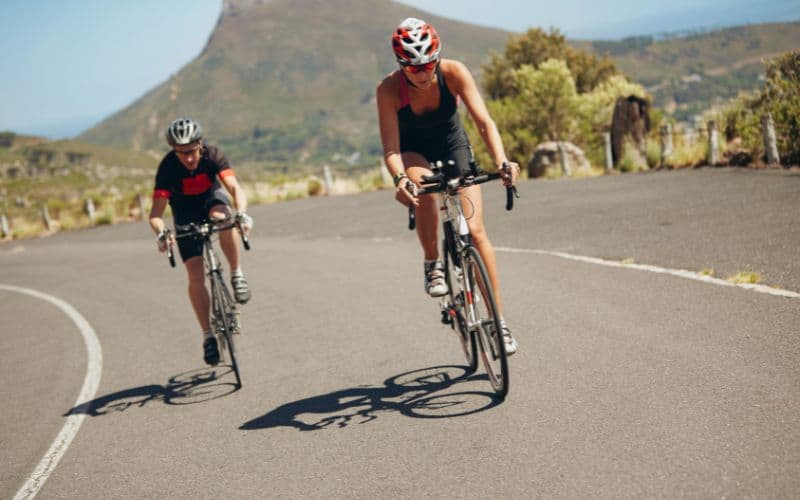
Effective Braking: Mastering the Stop
Effective braking is as crucial as pedaling. Here’s how to get it right:
- Even Pressure: Apply even pressure on both brakes.
- Anticipation: You wouldn’t slam the brakes when you’re on top of a pothole, would you? Always brake before you reach corners or obstacles.
- Wet Conditions: Just like how you’d slow down your car during a downpour, start braking earlier than usual in wet or slippery conditions to prevent skidding.
- Avoid Hard Braking: Sudden, hard braking can lead to losing control. Practice smooth, controlled braking.
Road Safety: Cycling With Care
Lastly, but most importantly, let’s talk about road safety. As a road cyclist, you share the space with pedestrians, cars, and other cyclists.
- Follow the Rules: Always obey traffic rules.
- Be Visible: Wear bright colors and use lights and reflectors on your bike. It’s not just a fashion statement. It’s a lifesaver!
- Communicate: Use hand signals to indicate turns or stops.
- Handle Emergencies: Learn how to deal with emergencies like fixing a flat or minor accidents.
As with any new skill, start with the basics.
Start with flat, quiet roads before gradually increasing your speed and distance.
Practice your pedaling, braking, gear shifting, and steering techniques in a safe, open area (like a parking lot) before you venture out on busy roads.
You can even try riding with one hand. Trust me, it’s possible, and it’s fun!
Cycling Accessories and Gear
Besides your bike, a few items are essential for every cyclist. These include:
- A Helmet
- A Water Bottle
- Basic Tools
Now, let’s look at how to select the right ones for you.
Safety First: The Helmet
Your helmet tops the list of essential cycling gear. It’s your primary line of defense, so don’t cut corners here.
A good helmet should fit snugly, have ample ventilation, and meet safety standards. The Consumer Product Safety Commission is a good resource for checking a helmet’s safety rating.
If you need more help, check out our guide on choosing the perfect helmet.
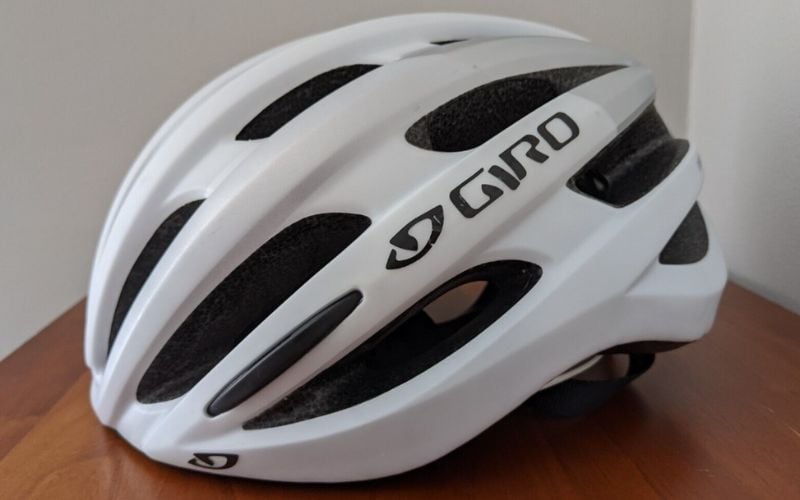
Stay Hydrated: The Water Bottle
Hydration is vital when pedaling away for hours.
Choose a water bottle that’s easy to use, fits securely in your bike’s bottle cage, and has enough capacity for your rides. Insulated bottles are excellent for keeping your drink cool during those scorching summer rides.
Be Prepared: Basic Tools
Finally, let’s talk about tools. At a minimum, you should carry a spare tube, tire levers, and a mini pump or CO2 inflator.
These tools can be a lifesaver in the case of a flat. You can carry them in a small saddle bag or a cycling backpack.
Quality vs. Price: Avoid the Traps
While it’s tempting to go for budget-friendly options when starting, quality should never be compromised. As with most things in life, cutting corners could cost you more in the long run.
Steer clear of cheap or counterfeit products that may not provide the safety or durability you need. Always opt for authentic products from trustworthy sellers.
Cycling Clothing and Apparel
Have you ever wondered why cyclists seem to have a uniform? It’s not just about aesthetics. Cycling clothing serves a purpose.
It offers comfort, enhances performance, and ensures safety while riding. This is why you often see MAMIL (middle-aged men in lycra)!
Let’s explore why you should invest in quality cycling gear and how to choose wisely.
Why Cycling Clothing Matters
Cycling clothing isn’t just a fashion statement; it’s an essential part of your gear. Here’s why:
- Comfort: The right cycling apparel can significantly improve your comfort during long rides. They’re designed to wick moisture away from your body, keeping you dry and reducing the risk of chafing.
- Performance: High-quality cycling clothes can enhance performance by reducing air resistance. The body-hugging design of cycling jerseys and shorts reduces drag, enabling you to cycle faster with less effort.
- Safety: Cycling gear often includes reflective elements that make you more visible to drivers, particularly during night rides or in low-light conditions.
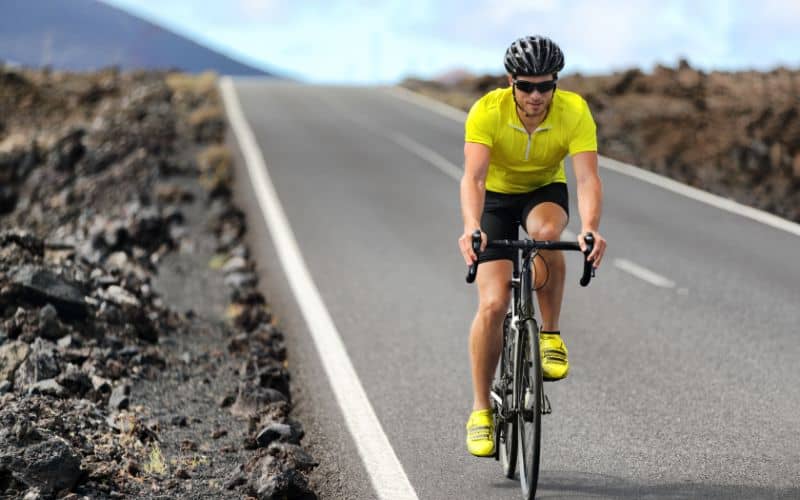
Choosing Your Cycling Apparel: The 5Fs to Consider
With so many choices, shopping for cycling clothes can be overwhelming. My advice: remember the 5Fs – Fit, Fabric, Features, Function, and Fashion.
- Fit: Cycling clothes should be snug but not restrictive. A good fit ensures better sweat-wicking and less air resistance.
- Fabric: Look for breathable performance fabrics that wick sweat away and dry quickly.
- Features: Consider the features you want. Do you need pockets for storing energy bars? A longer back hem for when you’re bent over the handlebars?
- Function: What’s the primary purpose of the clothing piece? For instance, if you’re looking for a winter cycling jacket, focus on thermal insulation and windproofing.
- Fashion: While performance is key, you also want to feel good in your apparel. Choose colors and designs that reflect your personality.
Caring for Your Cycling Clothing
Proper maintenance can prolong the lifespan of your cycling apparel. Always follow the washing instructions on the garment label.
Wash cycling clothes in cold water and let them air dry. Store them in a dry place away from direct sunlight to prevent fabric degradation.
Seasonal Cycling Clothing Guide
- Summer: Choose lightweight, breathable clothing to keep cool. Wear a cap under your helmet for sun protection.
- Winter: Layer up for winter cycling. Start with a moisture-wicking base layer, add a thermal middle layer, and finish with a windproof and waterproof outer layer.
- Rainy weather: A good waterproof jacket is essential. Look for one that is also breathable to prevent overheating.
- Night riding: Visibility is crucial. Wear clothing with reflective elements and consider LED lights for added safety.
Finding the Best Brands and Products
There’s no shortage of great cycling clothing brands.
Some of my favorites include Rapha, Castelli, and Pearl Izumi. To find what suits you best, check out reviews and ratings on cycling forums, blogs, and magazines.
Not to brag, but we also have a great resource of unbiased cycling apparel reviews. 😉
And remember, whether you’re gearing up for a casual ride, training session, or a race, the right clothing can make a world of difference!
Cycling Shoes and Pedals
You’ve just started road biking and wonder, “Do I really need to buy cycling shoes? Can’t I just pedal away in my regular sneakers?”
When cycling, your feet are the primary contact points between you and your bike. They are crucial in transferring power from your legs to the bike.
This is where cycling-specific pedals and shoes come in. They’re designed to maximize your pedaling efficiency, ensuring that every ounce of effort you put in yields the maximum output.
The right combination of cycling shoes and pedals can significantly improve your comfort on the bike, especially during those long rides.
Last but not least, they play a critical role in ensuring safety. With the correct setup, you’re less likely to slip off the pedals, reducing the risk of accidents.
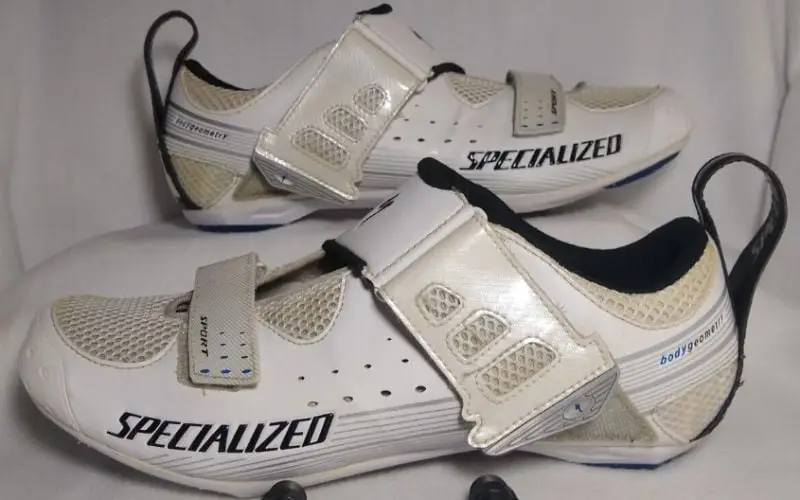
Choosing the Right Pedals and Shoes: What to Look For
The cycling market is flooded with choices for pedals and shoes. So, how do you choose the right pair?
- Compatibility: Ensure that your shoes and pedals are compatible. For instance, road bike shoes typically have a three-hole cleat system that fits most road bike pedals.
- Weight: In the cycling world, weight is everything. Lighter gear typically leads to faster rides. However, don’t sacrifice durability for shedding a few grams.
- Aerodynamics: While not a deal-breaker, aerodynamic shoes and pedals can give you that extra edge, especially in a race scenario.
- Adjustability: Your pedals should allow you to adjust the tension for clipping in and out. Likewise, your shoes should have adjustable cleat positioning.
- Durability: Look for well-built, durable shoes and pedals that can withstand the wear and tear of regular use.
Maintenance Tips for Your Cycling Shoes and Pedals
Like any other part of your bike, your pedals and shoes need regular care and maintenance. Here are some tips to keep them in top condition:
- Learn how to clip in and out smoothly to avoid unnecessary stress on the pedals and shoes.
- Adjust your cleat position and tension for optimum comfort and efficiency.
- Clean and lubricate your pedals regularly to keep them functioning smoothly.
- Replace your cleats when worn out to maintain a secure connection between your shoes and pedals.
Cycling Shoes and Pedals for Every Rider
The type of cycling you’re into also influences your choice of pedals and shoes.
Racers might lean towards lightweight, aerodynamic options, while endurance riders prioritize comfort and adjustability. Gravel and cyclocross riders, on the other hand, usually opt for more durable and rugged options.
Top Brands and Models
As for recommendations, there’s no one-size-fits-all. Different brands and models cater to different needs and budgets.
However, brands like Shimano, Look, and Sidi consistently rank high in reviews and ratings. We have a selection of road bike cycling shoes to get you started.
Now that you’ve got the lowdown on cycling shoes and pedals, it’s time to gear up.
Additional Tips for New Cyclists
Avoiding Common Mistakes and Injuries
First and foremost, don’t overdo it. Trust me, I know how tempting it can be to push your limits, but your body needs time to adapt.
Follow a progressive training plan and remember to take rest and recovery days. This will help prevent overuse injuries that can sideline you for weeks or months.
Next, always warm up properly and stretch after riding. This prepares your muscles for the ride ahead and helps prevent stiffness afterward.
Fueling your body correctly is also crucial. Regular hydration and a balanced diet can keep you from bonking (a term cyclists use for hitting an energy wall), which is as unpleasant as it sounds.
And finally, listen to your body. If you’re feeling a twinge that’s more than just the usual muscle fatigue, it might be time to take a break. There’s no shame in taking it easy!
Dealing with Common Challenges: Weather, Flat Tires, and More
Cycling throws a few curveballs your way, and that’s part of its charm! While we can’t predict an unexpected rain shower, we can certainly be prepared.
Always check the forecast before heading out, dress appropriately, and carry extra layers or accessories. A lightweight waterproof jacket, for instance, can be a lifesaver during a sudden downpour.
Flat tires are an inevitable part of cycling. Always carry essentials like a spare tube, a pump, and a patch kit. If you’re unsure how to handle a flat, check out this instructional video:
And remember, accidents can happen. Stay calm, assess your situation, and call for help if needed. It’s always wise to carry an ID, some cash, and emergency contact numbers.
Making Road Cycling More Enjoyable: Join a Club, Explore, and Set Goals
Now for the fun part! As goofy as it sounds, road cycling is more than just a sport – it’s a lifestyle.
Joining a club or a group ride can be a great way to meet fellow cyclists and learn from their experiences. Websites like meetup.com often list local cycling groups that welcome newcomers.
Exploring new routes or destinations can also add a sense of adventure to your rides. Apps like Strava or Komoot are great for discovering new paths and tracking progress.
Setting personal goals and challenges can be a powerful motivator. You can complete a Gran Fondo or conquer a local mountain. Whatever your objective, remember to celebrate your achievements – because you earned it!
Road cycling is a rewarding and exhilarating to stay fit, explore new places, and make new friends.
So saddle up, stay safe, and enjoy the ride!

